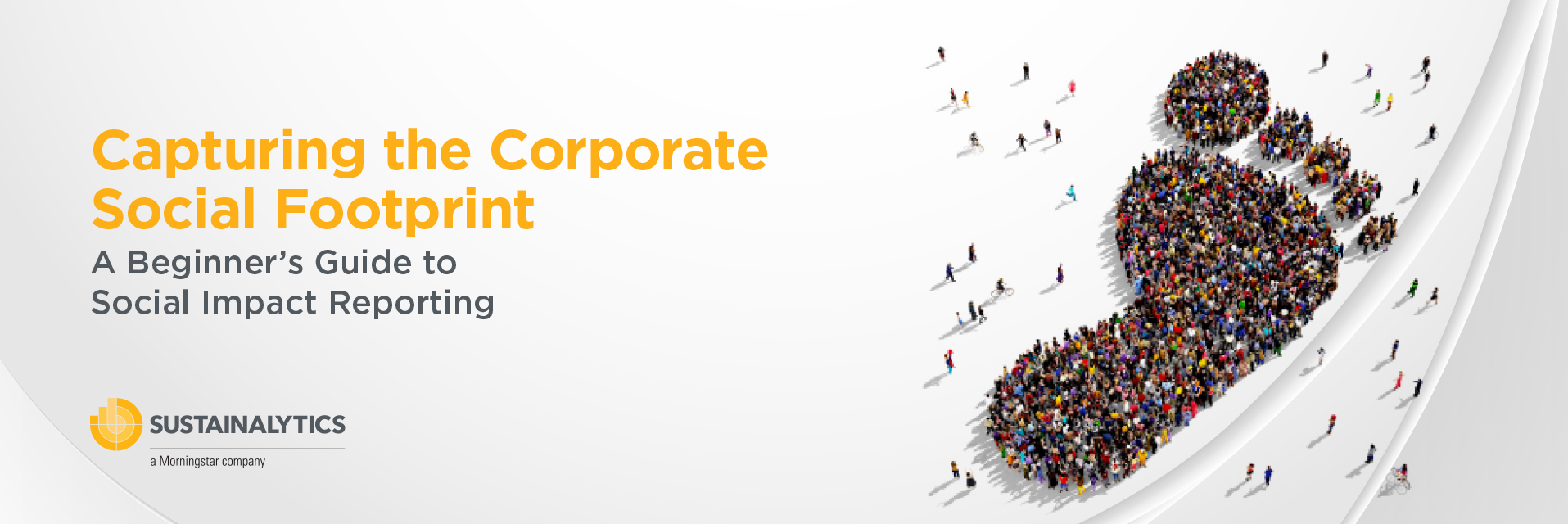With environmental, social, and corporate governance (ESG) becoming top of mind for businesses and consumers, growing demand from stakeholders is driving many companies to quantify their social impacts. These impacts may be simple to identify, yet challenging to measure. Unlike environmental reporting, which has universally recognized approaches[i] and easily quantifiable metrics (e.g., greenhouse gas emissions, water usage, etc.), reporting on social impacts is less developed due to challenges in capturing the scope of a firm’s social footprint.
However, with emerging measurement tools and greater data availability on suppliers, capturing your social impact need not be a huge undertaking. Here are five steps for your organization to consider when reporting on your firm’s social impacts.
Step One: Define Your Social Impact Report’s Scope
Before collecting data and contacting stakeholders, decide on your social impact report’s scope and identify the topic boundaries for each of the material topics covered.[ii] Are you including subsidiaries’ impacts or only the parent company’s impacts? What is the time frame and topic boundaries of the report? Narrow reporting boundaries can draw criticism as many organizational impacts – both positive and negative – occur within a firm’s supply chain.[iii] Ensure your analysis looks beyond your company’s immediate activities to include indirect impacts, such as economic growth across the supply chain, or the long-term effects of educational programs.
Step Two: Determine Your Social Impact Reporting Format
Social impact reporting can be integrated into existing public disclosures, or be a separate communications strategy. Consider whether to produce a standalone report or include social impacts disclosures within a sustainability report, annual report, or on your company’s website. Dell Technologies, for example, produces standalone social impact reports, while Starbucks integrates social impact disclosures into its annual sustainability report. Some companies, like Standard Chartered, produce country-specific socio-economic impact reports to further detail their regional impacts.
During this stage, explore whether you would like to align reporting with existing impact frameworks, such as the UN’s Sustainable Development Goals (SDGs). For example, Salesforce reports on its social impacts by U.S. dollar amount across each of the SDGs, including mapping its customer base and employee giving to its respective contribution to individual SDGs. Investigating how industry peers are reporting on social impacts can also help provide direction on the format of your report and possible frameworks to use.
Step Three: Select Meaningful Indicators to Report On
Once your reporting boundaries and format are decided, select clearly defined, relevant, balanced, and comparable indicators to measure and report your social impacts. Key stakeholders can also be consulted as part of the selection process to ensure meaningful indicators are chosen and reported on.
Use a mix of input, output, and outcome indicators to capture not only resources expended (i.e., dollars spent) but also the long-term effects or deliverables produced (i.e., improved education outcomes or economic growth). For example, in its social impact reporting, Dell Technologies uses input indicators such as the dollar amount of its diverse supply chain spend as well as output and outcomes indicators on improved health and safety, ethical recruitment practices and labor management among suppliers’ workforces.
Step Four: Collect and Present Your Data
Explore new measurement techniques and tools to help gather data for the selected indicators. Present data with the help of visuals, such as interactive infographics on your company’s website.
Be sure to include a description of data collection methods used (i.e., survey, platforms or tools used) and consider the inclusion of anecdotal evidence, including case studies and stakeholder interviews to demonstrate the beneficiaries’ stories. Reuters, for instance, shares short case studies of the long-term results of its social impact work alongside its quantitative-focused indicators. Manufacturing company, Kohler, weaves storytelling into its social impact report, detailing how its corporate philanthropy programs affect the well-being of individuals who may have never heard the name Kohler before.
Step Five: Continue Engagement and Evaluation
Avoid making social impact reporting a ‘box-ticking’ exercise. Instead, learn from your data and act on areas in need of improvement. Standard Chartered’s social impact reports identify local development gaps and analyzes how its positive impacts can be improved. If initiating a large-scale social impact project requiring external funding, consider using social bonds. In terms of the report itself, seek input from stakeholders on how to improve future reports and seek appropriate channels to continue to promote the report to your stakeholders.
For more essential actions to take on social impact reporting, read our latest ebook, Capturing the Corporate Social Footprint: A Beginner’s Guide to Social Impact Reporting.
[i] Environmental reporting standards and suggested indicators include those provided by the CDP (formally known as the Carbon Disclosure Project), Global Reporting Initiative (GRI), Task Force on Climate-related Financial Disclosures (TCFD), and Greenhouse Gas Protocol.
[ii] Material topics can be identified and prioritized by the significance of the firm’s social impact and their influence on stakeholders’ decision-making. GRI (2016), “GRI 101: Foundation 2016,“ Global Reporting Initiative, accessed (16.06.21): https://www.globalreporting.org/standards/media/1036/gri-101-foundation-2016.pdf#page=18
[iii] Bové, A. and Swartz, S. (2016), “Starting at the source: Sustainability in supply chains, “ McKinsey & Company, accessed (25.05.21) at: https://www.mckinsey.com/business-functions/sustainability/our-insights/starting-at-the-source-sustainability-in-supply-chains
[iv] Henriques, A. (2015). ‘Corporate Impact: Measuring and Managing Your Social Footprint,’ Routledge
Recent Content
Risk and Opportunity in Biodiversity: How Sustainable Finance Can Help
This article outlines how biodiversity loss poses material risks to business and how it connects to many other issues that companies can’t ignore. In addition, it covers how biodiversity conservation presents substantial economic opportunities, and how businesses can address and access these opportunities by issuing linked instruments that integrate biodiversity considerations.
Today’s Sustainable Bond Market: Boosting Confidence in Sustainable Bond Issuances
In this article, we examine the kinds of sustainable bonds offered in the market, some of the key regulations being developed in different markets and the current initiatives to improve the quality and credibility of issuances.
Webinar Recap: How Integrating ESG Can Drive Opportunity for Private Companies
Recently, Morningstar Sustainalytics hosted a webinar – ESG in the Lifecycle of a Private Company: How Stakeholder Demands Drive Sustainability in Private Markets – to address some of the questions private companies might have surrounding ESG and how it could impact their business.





